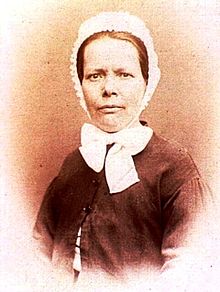Nathalie Lemel

Nathalie Lemel (26 August 1827 – 1921
Bookbinder
Nathalie Lemel was born in
Militant
She worked as a bookbinder and retailer in Paris, and then became a socialist activist.
She was noticed because of her intense excitement and her political activism; in the workshops, she read bad newspapers aloud; she assiduously frequented the [union] clubs.
This was in addition to her strong opposition to the
Activist
The insurrection began on 18 March 1871. After that date, Lemel was very active in the women's clubs where she often made speeches. These speeches helped to create, with Elisabeth Dmitrieff (a protégée of Karl Marx), the Women's Union for the Defense of Paris and Care of the Wounded, on 11 April, of which she became a member of the central committee.
On 26 March, following the elections, a revolutionary council was put in place, which counted people such as
After the defeat of the Commune, the War Council condemned her to deportation and exile in the
Death and legacy
She died in 1921 in the hospice of Ivry-sur-Seine, in Val-de-Marne.

In 2007, a previously anonymous square in the 3rd arrondissement of Paris was named in honour of Nathalie Lemel on International Women's Day (8 March) by decision of the arrondissement council. The place Nathalie Lemel, at the junction of the rue Dupetit-Thouars and the rue de la Corderie, is the site of the former headquarters of the International Workingmen's Association (the First International). Lemel herself lived nearby, in a road then called impasse Béranger.
There are also rues Nathalie Lemel in
References
- ^ Thomas, Edith (1980). Louise Michel. Black Rose Books. p. 142.
- ISBN 978-2-85816-468-4. Retrieved 15 October 2010.
Née le 26 août 1827 à Brest, Finistère.
- ISBN 9782867510281. Retrieved 15 October 2010.
Elle est née en 1827 à BREST et morte en 1921. Son combat fut très important sous la Commune
- ISBN 978-0-253-21705-9. Retrieved 15 October 2010.
- ISBN 978-0-8014-9140-5. Retrieved 15 October 2010.
- ISBN 978-2-7384-5981-7. Retrieved 15 October 2010.
- ISBN 9780870231193. Retrieved 15 October 2010.
- ^ Sowerwine, Charles (1973). Women and socialism in France, 1871-1921: socialist women's groups from Leonie Rouzade to Louise Saumoneau. University of Wisconsin--Madison. p. 3. Retrieved 15 October 2010.
- ISBN 9782840963455. Retrieved 15 October 2010.
- ^ À Brest, une fresque monumentale dessinée par deux stars du Street Art : Guy Denning et Shoof "Une fresque représentant Nathalie Lemel, figure féministe du XIXe siècle, vient d’être réalisée sur les murs..." 24 March 2016 www.connaissancedesarts.com accessed 27 February 2020
